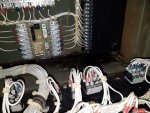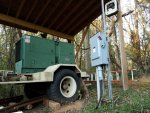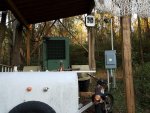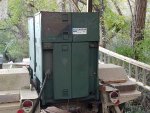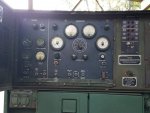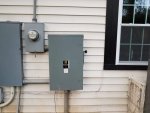gdg111,
All three filter housings use the same O-ring. The copper washers under the flow through bolts can leak, but if they are dry, don't worry about it. The same for the copper washer under the domed nut, (acorn nut). If they work, don't screw with them. I would maybe get some to keep on hand, and they are cheap, but if you replaced the two filters and no leaks, it golden.
The different number on the filters is no big deal. The military went with several different sources of filters. No matter what NSN you use, you get the same filters. Or filters that will work.
Do take a flashlight and shine it down into the fuel tank. If you see anything like quicksilver in the tank, its water. That's what the petcocks are for on your fuel filtering system are for. Turn on the S1 to the run position, the electric fuel pumps come on, pressurize the fuel system, and then you can let a bit of fuel out into a glass. Check your output, if its got water or dirt, think about pulling the tank and cleaning it.
You do not need a mechanic to help you. Read the books, not once, but twice. Then try to do it yourself. After watching your mechanic, you should be able to do a service yourself, with a little reading. This is not rocket science.
If and when you do the water strainer, after cleaning/replacing or what ever, put a pile of rags down under the filter housing. Replace the housing, tighten up the domed nut, finger tight. Turn on the S1 to run, and wait until the fuel starts to drip out of the housing. THEN tighten up the domed nut. Air is bled out of the system. From the strainer to the injectors, its self bleeding anyway.
A good trick to remember when replacing fuel filter housings is to spin the housing, just before you tighten them down. It centers the housing, and tends to push up the gaskets/O-rings into the filter head better. Less chance of a leak. I once, long, long, long ago, got all three gaskets in wrong. If you think it bleeds oil like a pig, get all the filter gaskets wrong! Then you will see something on the scale of Niagara Falls.
This is a killer gen set if you keep the fuel, oil and air filters changed when it needs them. There are also filters in the electric fuel pumps. On the bottom of the pumps, should be a nut, if I remember right, 5/8th wrench (?) and when you take off the bottom cap, there will come a flood of fuel, then the plastic filters, and there will also be a magnet in there. Take it all out, clean it and then replace it just like it came out. If the fuel pump strainers are crudded up, then take a REAL good look at the fuel tank. That is the very FIRST line of fuel straining and filtering.



